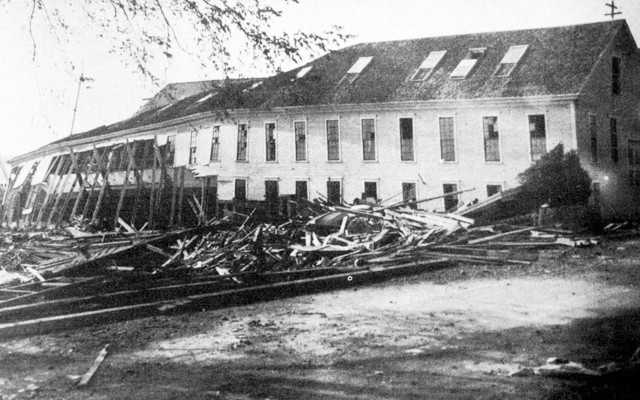
by Erin Wayman Tuesday, September 1, 2015

The Great New England Hurricane of 1938 had wind speeds in excess of 160 kilometers per hour. The winds destroyed this building in Bristol, R.I. Credit: NOAA'S National Weather Service Collection.
After a disappointing golf outing (the wind made it impossible to drive a golf ball anywhere but straight up), golf pro Raymond Dennehy and his friends returned to the clubhouse of the seaside Kittansett Golf Club in Marion, Mass. Dennehy noticed something wrong: The incoming tide was much higher than normal. In fact, the ocean rose so high that it cut off the club’s grounds from the rest of the state. Then a car floated by./ As water filled the clubhouse, Dennehy took his German shepherd and ran to his car. He drove to the highest point on the golf course and waited. Sitting in the parked car with water around his ankles, Dennehy watched the two-story yacht club collapse under the weight of the rising water. Cottages crumpled. Panicked golf caddies climbed an oak tree to escape the rising sea.
Several hours later, the water receded, leaving behind chunks of wrecked buildings, sand and even a bathtub. Dennehy and his dog had just survived the Great New England Hurricane of 1938. The storm killed 564 people, damaged nearly 24,000 buildings and uprooted billions of trees.
The storm had begun brewing more than two weeks earlier on Sept. 4 near the Cape Verde Islands off the west coast of Africa. After traveling across the Atlantic, it grew into a Category-5 hurricane on Sept. 18. Directly north of Puerto Rico and east of the Bahamas, the hurricane traveled 24 kilometers per hour toward southern Florida. Weather forecasters at the U.S. Weather Bureau (now the National Weather Service) issued a warning: The hurricane would hit Miami on Sept. 20.
But the next day, the storm changed course. Now moving north, the hurricane no longer threatened the Florida coast. Weather forecasters in Florida passed on the responsibility of tracking the storm to forecasters at the Washington, D.C., branch of the U.S. Weather Bureau. Later in the day, the storm moved beyond the view of observation stations and ships. Weather forecasters predicted the storm would curve farther and farther out to sea until it eventually settled down, just as similar storms had always done.
One weather forecaster, however, offered a different view. Charlie Pierce, a substitute forecaster filling in that day, suggested that a high-pressure front could push the storm toward New England — an idea that no one in the Weather Bureau took seriously.
On Sept. 21, the now Category-3 hurricane reappeared east of North Carolina’s Cape Hatteras at 7:00 a.m., traveling three times faster than it had been and forcing forecasters to rethink the storm’s path. The hurricane’s unusually swift speed — giving it the nickname the “Long Island Express” — allowed it to quickly pass over the colder waters north of Cape Hatteras that could have weakened the storm.
By 10:30 a.m., the Weather Bureau started to issue storm warnings, but other news — Adolf Hitler’s invasion of Czechoslovakia — dominated the day. Therefore, residents along the southern coast of Long Island were not prepared when the Category-3 hurricane slammed into the East Coast during the early afternoon. Nor were workers in downtown Providence, R.I., prepared for the six-meter-tall storm surge that swallowed the city. After sweeping through New York, Connecticut, Rhode Island and Massachusetts, the storm arrived in Vermont at 8:00 p.m. before dying over Montreal hours later.
The hurricane’s landfall coincided with the highest tide of the year, exacerbating the flooding. Three days of rain prior to the storm also intensified the deluge. By the storm’s end, parts of New England, such as the Connecticut River Valley, were wetter than the wettest time anyone could remember.
The hurricane proved to be a costly disaster. In addition to the human death toll, thousands of chickens and other livestock died during the storm. And the region’s apple crops and maple sugar trees were ruined. Cleaning up and rebuilding the storm-ravaged parts of New England cost billions, which made it one of the nation’s costliest hurricanes in history. The lack of proper warnings led to much of the death and destruction; at the time, few weather forecasters thought a storm of that magnitude — with winds in excess of 160 kilometers per hour — could strike New England.
Since 1938, no other hurricane has pummeled New England so intensely. And at the time, most New Englanders had never experienced a hurricane. So when Dennehy called his boss, who lived north of where the storm hit, to tell him that the week’s golf tournament would have to be cancelled, his boss was skeptical. He asked Dennehy if he had been drinking. Dennehy replied, “No, but I wish to hell I had.”
© 2008-2021. All rights reserved. Any copying, redistribution or retransmission of any of the contents of this service without the expressed written permission of the American Geosciences Institute is expressly prohibited. Click here for all copyright requests.